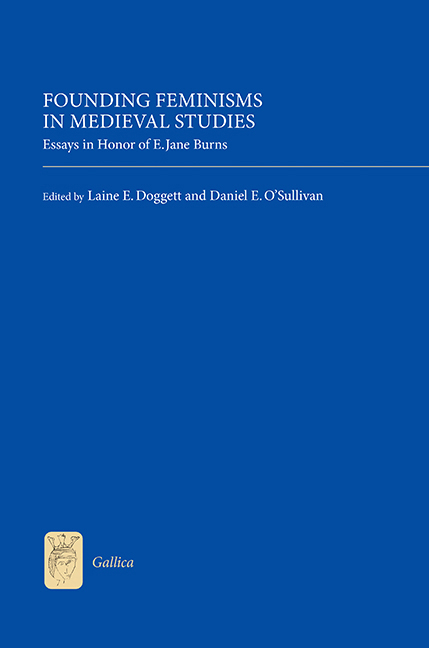Book contents
- Frontmatter
- Contents
- List of Illustrations
- List of Contributors
- Acknowledgements
- Introduction: The Work of E. Jane Burns and the Feminisms of Medieval Studies
- E. Jane Burns: A Bibliography
- Part I Debating Gender
- Part II Sartorial Bodies
- Part III Mapping Margins
- Women's Healing: From Binaries to a Nexus
- Silk in the Age of Marco Polo
- Another Land's End of Literature: Honorat Bovet and the Timbuktu Effect
- Part IV Female Authority: Networks and Influence
- Afterword: A Response to the Volume
- Index
- Tabula Gratulatoria
- Already Published
Women's Healing: From Binaries to a Nexus
from Part III - Mapping Margins
Published online by Cambridge University Press: 05 July 2016
- Frontmatter
- Contents
- List of Illustrations
- List of Contributors
- Acknowledgements
- Introduction: The Work of E. Jane Burns and the Feminisms of Medieval Studies
- E. Jane Burns: A Bibliography
- Part I Debating Gender
- Part II Sartorial Bodies
- Part III Mapping Margins
- Women's Healing: From Binaries to a Nexus
- Silk in the Age of Marco Polo
- Another Land's End of Literature: Honorat Bovet and the Timbuktu Effect
- Part IV Female Authority: Networks and Influence
- Afterword: A Response to the Volume
- Index
- Tabula Gratulatoria
- Already Published
Summary
Old French medieval literature abounds with examples in which a woman quickly and confidently treats a battle wound. In this article I analyze episodes from several twelfth-and thirteenth-century Old French romances, epics, and the chantefable Aucassin et Nicolette that portray women ministering to and healing a knight's battle wounds. At first glance, the means to heal, nothing more than plant derivatives, may appear simplistic and lacking value. However, the flora is known for its healing virtues, in many cases as a symbol of God's providence for humans, carefully infused into highly valued formulations, applied in skilled ways by informally trained healers in a long line of tradition; and the salves bring excellent results with the help of God. This entire set of highly connected associations – healing, plant matter, the natural world, order and plan in cosmology, God's providence, and the application of human intelligence – underscores the complexity of healing. To fully perceive the interrelated and overlapping aspects of healing in these texts we must apply a “both/and” logic rather than an “either/or,” an additive comprehension rather than a divisional or divisive one, a strategy that informs the work of E. Jane Burns. The depiction of healing in the texts under consideration here provides but one example of the necessity of reading the entire set of overlapping and intermingling associations instead of applying binaries such as courtly/non-courtly, magic/religion, and magic/proto-science. Such binaries can impose hierarchies of knowledge and skills that did not inhere in the high Middle Ages and obscure the complementarity of aspects of healing.
The healers apply a vast store of antique and medieval lore on plants and their virtues that affect the human body, knowledge that was transmitted orally and in writing, much of it from the East. Formally and informally trained healers, both male and female, applied these remedies. In some cases, critics call the techniques and/or characters magic, and move on. This overlooks the varied and often conflicting uses of the word in the high Middle Ages, the extensive naturalistic plant lore transmitted, and the overlap of magic and medicine at the time. When applied by modern critics, the word magic is often devoid of context, a move that disregards the knowledge and skills of female healers and easily permits modern binaries such as magic/science to shape our reception of these episodes.
- Type
- Chapter
- Information
- Founding Feminisms in Medieval StudiesEssays in Honor of E. Jane Burns, pp. 125 - 140Publisher: Boydell & BrewerPrint publication year: 2016

